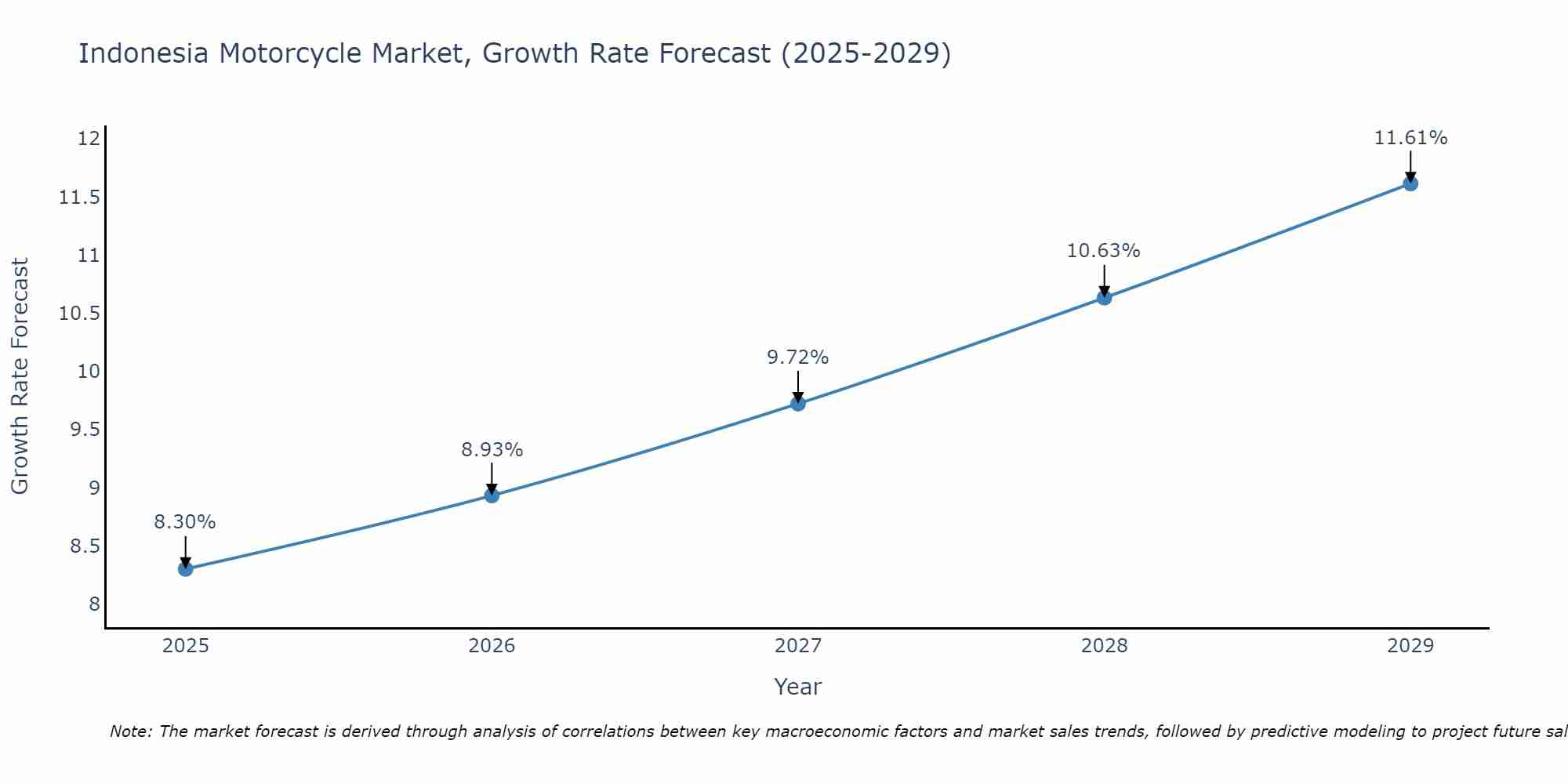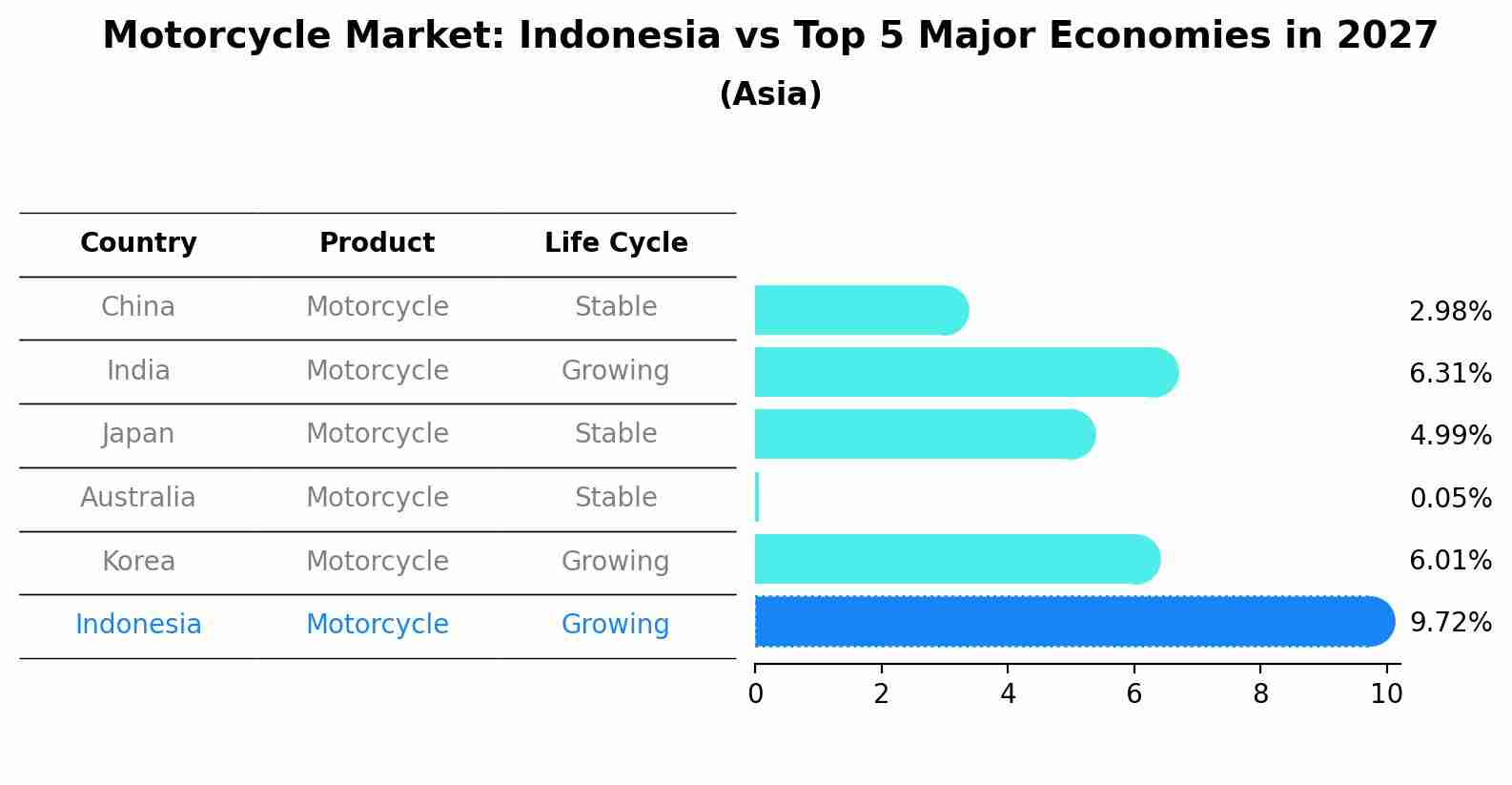Indonesia Motorcycle Market (2024-2030) | Forecast, Size, Share, Outlook, Analysis, Growth, Companies, Industry, Value, Trends & Revenue
| Product Code: ETC040089 | Publication Date: Jul 2023 | Updated Date: Apr 2025 | Product Type: Report | |
| Publisher: 6Wresearch | No. of Pages: 70 | No. of Figures: 35 | No. of Tables: 5 | |
Indonesia Motorcycle Market Size Growth Rate
The Indonesia Motorcycle Market is likely to experience consistent growth rate gains over the period 2025 to 2029. From 8.30% in 2025, the growth rate steadily ascends to 11.61% in 2029.

Motorcycle Market: Indonesia vs Top 5 Major Economies in 2027 (Asia)
By 2027, the Motorcycle market in Indonesia is anticipated to reach a growth rate of 9.72%, as part of an increasingly competitive Asia region, where China remains at the forefront, supported by India, Japan, Australia and South Korea, driving innovations and market adoption across sectors.

Indonesia Motorcycle Market Synopsis
The Indonesia motorcycle market is expected to grow at a CAGR of around 7% during theperiod 2020-2026. The growing availability of technologically advanced motorcycles and the rising incomes are some of the key factors that will fuelin the market over this period. Furthermore increased government initiatives to promote road safety and fuel efficiency coupled with better loan facilities for two wheelers will also aid in overall market expansion. Additionally increasing investment by major players is expected to offer some attractive opportunities for new entrants into the Indonesia motorcycle .
Key Factors Driving the Market
Increasing demand for technologically advanced bikes such as electric motorcycles and scooters with improved features like GPS navigation systems multimedia systems and anti-theft technologies will drivein the Indonesia motorcycle market over 2020-2026. With an increase in disposable incomes people can afford more luxurious vehicles which increases sales of higher-end models resulting in highergeneration from the motorbikes segment thus facilitating furtherprospects for the Indonesia motorcycleover theperiod.Government initiatives such as introducing stricter emission norms under Euro 3 standards have led manufacturers to shift towards eco-friendly vehicles as it reduces carbon emissions thus helping environment conservation while improving overall air quality leading to a steady rise in demand across the country over the past few years which will likely continue during ed timeframe as well.
Challenges Facing the Market
One major challenge faced by consumers when purchasing two wheelers is high cost associated with its maintenance due to the lack proper servicing centers infrastructure making it difficult repair any damage or replace worn-out parts resulting in lower adoption rates despite advancement technological features. Another impediment hampering theelectric bike segment lack dedicated charging networks long-distance connectivity options making them an unattractive choice among riders who may need to cover larger distances constantly thereby curtailing s generated from these products further.
Key Market Players
Some prominent players operating within Indonesia two wheeler space include Honda Motorcycle Indonesia (HMI) Yamaha Motor Manufacturing Corporation (YMMC) Kawasaki Motors Corp. Suzuki Motor Co. Ltd. TVS Motors Co. Piaggio Group India Pvt Ltd etc.
Key Highlights of the Report:
- Indonesia Motorcycle Market Outlook
- Market Size of Indonesia Motorcycle Market, 2023
- Forecast of Indonesia Motorcycle Market, 2030
- Historical Data and Forecast of Indonesia Motorcycle Revenues & Volume for the Period 2020-2030
- Indonesia Motorcycle Market Trend Evolution
- Indonesia Motorcycle Market Drivers and Challenges
- Indonesia Motorcycle Price Trends
- Indonesia Motorcycle Porter's Five Forces
- Indonesia Motorcycle Industry Life Cycle
- Historical Data and Forecast of Indonesia Motorcycle Market Revenues & Volume By Type for the Period 2020-2030
- Historical Data and Forecast of Indonesia Motorcycle Market Revenues & Volume By Adventure for the Period 2020-2030
- Historical Data and Forecast of Indonesia Motorcycle Market Revenues & Volume By Cruiser for the Period 2020-2030
- Historical Data and Forecast of Indonesia Motorcycle Market Revenues & Volume By Mopeds for the Period 2020-2030
- Historical Data and Forecast of Indonesia Motorcycle Market Revenues & Volume By Sports for the Period 2020-2030
- Historical Data and Forecast of Indonesia Motorcycle Market Revenues & Volume By Standard for the Period 2020-2030
- Historical Data and Forecast of Indonesia Motorcycle Market Revenues & Volume By Touring for the Period 2020-2030
- Historical Data and Forecast of Indonesia Motorcycle Market Revenues & Volume By Engine Capacity for the Period 2020-2030
- Historical Data and Forecast of Indonesia Motorcycle Market Revenues & Volume By 151-300 CC for the Period 2020-2030
- Historical Data and Forecast of Indonesia Motorcycle Market Revenues & Volume By 301-500 CC for the Period 2020-2030
- Historical Data and Forecast of Indonesia Motorcycle Market Revenues & Volume By 501-800 CC for the Period 2020-2030
- Historical Data and Forecast of Indonesia Motorcycle Market Revenues & Volume By 801-1000 CC for the Period 2020-2030
- Historical Data and Forecast of Indonesia Motorcycle Market Revenues & Volume By 1001-1600 CC for the Period 2020-2030
- Historical Data and Forecast of Indonesia Motorcycle Market Revenues & Volume By Above 1600 CC for the Period 2020-2030
- Indonesia Motorcycle Import Export Trade Statistics
- Market Opportunity Assessment By Type
- Market Opportunity Assessment By Engine Capacity
- Indonesia Motorcycle Top Companies Market Share
- Indonesia Motorcycle Competitive Benchmarking By Technical and Operational Parameters
- Indonesia Motorcycle Company Profiles
- Indonesia Motorcycle Key Strategic Recommendations
Frequently Asked Questions About the Market Study (FAQs):
1 Executive Summary |
2 Introduction |
2.1 Key Highlights of the Report |
2.2 Report Description |
2.3 Market Scope & Segmentation |
2.4 Research Methodology |
2.5 Assumptions |
3 Indonesia Motorcycle Market Overview |
3.1 Indonesia Country Macro Economic Indicators |
3.2 Indonesia Motorcycle Market Revenues & Volume, 2020 & 2030F |
3.3 Indonesia Motorcycle Market - Industry Life Cycle |
3.4 Indonesia Motorcycle Market - Porter's Five Forces |
3.5 Indonesia Motorcycle Market Revenues & Volume Share, By Type, 2020 & 2030F |
3.6 Indonesia Motorcycle Market Revenues & Volume Share, By Engine Capacity, 2020 & 2030F |
4 Indonesia Motorcycle Market Dynamics |
4.1 Impact Analysis |
4.2 Market Drivers |
4.3 Market Restraints |
5 Indonesia Motorcycle Market Trends |
6 Indonesia Motorcycle Market, By Types |
6.1 Indonesia Motorcycle Market, By Type |
6.1.1 Overview and Analysis |
6.1.2 Indonesia Motorcycle Market Revenues & Volume, By Type, 2020-2030F |
6.1.3 Indonesia Motorcycle Market Revenues & Volume, By Adventure, 2020-2030F |
6.1.4 Indonesia Motorcycle Market Revenues & Volume, By Cruiser, 2020-2030F |
6.1.5 Indonesia Motorcycle Market Revenues & Volume, By Mopeds, 2020-2030F |
6.1.6 Indonesia Motorcycle Market Revenues & Volume, By Sports, 2020-2030F |
6.1.7 Indonesia Motorcycle Market Revenues & Volume, By Standard, 2020-2030F |
6.1.8 Indonesia Motorcycle Market Revenues & Volume, By Touring, 2020-2030F |
6.2 Indonesia Motorcycle Market, By Engine Capacity |
6.2.1 Overview and Analysis |
6.2.2 Indonesia Motorcycle Market Revenues & Volume, By 151-300 CC, 2020-2030F |
6.2.3 Indonesia Motorcycle Market Revenues & Volume, By 301-500 CC, 2020-2030F |
6.2.4 Indonesia Motorcycle Market Revenues & Volume, By 501-800 CC, 2020-2030F |
6.2.5 Indonesia Motorcycle Market Revenues & Volume, By 801-1000 CC, 2020-2030F |
6.2.6 Indonesia Motorcycle Market Revenues & Volume, By 1001-1600 CC, 2020-2030F |
6.2.7 Indonesia Motorcycle Market Revenues & Volume, By Above 1600 CC, 2020-2030F |
7 Indonesia Motorcycle Market Import-Export Trade Statistics |
7.1 Indonesia Motorcycle Market Export to Major Countries |
7.2 Indonesia Motorcycle Market Imports from Major Countries |
8 Indonesia Motorcycle Market Key Performance Indicators |
9 Indonesia Motorcycle Market - Opportunity Assessment |
9.1 Indonesia Motorcycle Market Opportunity Assessment, By Type, 2020 & 2030F |
9.2 Indonesia Motorcycle Market Opportunity Assessment, By Engine Capacity, 2020 & 2030F |
10 Indonesia Motorcycle Market - Competitive Landscape |
10.1 Indonesia Motorcycle Market Revenue Share, By Companies, 2023 |
10.2 Indonesia Motorcycle Market Competitive Benchmarking, By Operating and Technical Parameters |
11 Company Profiles |
12 Recommendations |
13 Disclaimer |
- Single User License$ 1,995
- Department License$ 2,400
- Site License$ 3,120
- Global License$ 3,795
Search
Related Reports
- Portugal Electronic Document Management Market (2025-2031) | Strategy, Consumer Insights, Analysis, Investment Trends, Opportunities, Growth, Size, Share, Industry, Revenue, Segments, Value, Segmentation, Supply, Forecast, Restraints, Outlook, Competition, Drivers, Trends, Demand, Pricing Analysis, Competitive, Strategic Insights, Companies, Challenges
- France Electronic Document Management Market (2025-2031) | Strategy, Consumer Insights, Analysis, Investment Trends, Opportunities, Growth, Size, Share, Industry, Revenue, Segments, Value, Segmentation, Supply, Forecast, Restraints, Outlook, Competition, Drivers, Trends, Demand, Pricing Analysis, Competitive, Strategic Insights, Companies, Challenges
- Portugal Occupational Health & Safety Services Market (2025-2031) | Strategy, Consumer Insights, Analysis, Investment Trends, Opportunities, Growth, Size, Share, Industry, Revenue, Segments, Value, Segmentation, Supply, Forecast, Restraints, Outlook, Competition, Drivers, Trends, Demand, Pricing Analysis, Competitive, Strategic Insights, Companies, Challenges
- Netherlands Occupational Health and Safety Services Market (2025-2031) | Strategy, Consumer Insights, Analysis, Investment Trends, Opportunities, Growth, Size, Share, Industry, Revenue, Segments, Value, Segmentation, Supply, Forecast, Restraints, Outlook, Competition, Drivers, Trends, Demand, Pricing Analysis, Competitive, Strategic Insights, Companies, Challenges
- Belgium and Luxembourg Facility Management Market (2025-2031) | Strategy, Consumer Insights, Analysis, Investment Trends, Opportunities, Growth, Size, Share, Industry, Revenue, Segments, Value, Segmentation, Supply, Forecast, Restraints, Outlook, Competition, Drivers, Trends, Demand, Pricing Analysis, Competitive, Strategic Insights, Companies, Challenges
- Russia Women Intimate Apparel Market (2025-2031) | Strategy, Consumer Insights, Analysis, Investment Trends, Opportunities, Growth, Size, Share, Industry, Revenue, Segments, Value, Segmentation, Supply, Forecast, Restraints, Outlook, Competition, Drivers, Trends, Demand, Pricing Analysis, Competitive, Strategic Insights, Companies, Challenges
- Africa Chocolate Market (2025-2031) | Size, Share, Trends, Growth, Revenue, Analysis, Forecast, industry & Outlook
- Global Hydroxychloroquine And Chloroquine Market (2025-2031) | Industry, Trends, Size, Outlook, Growth, Value, Companies, Revenue, Analysis, Share, Forecast
- Saudi Arabia Plant Maintenance Market (2025-2031) | Industry, Size, Growth, Revenue, Value, Companies, Forecast, Analysis, Share & Trends
- Taiwan Electric Truck Market (2025-2031) | Outlook, Industry, Revenue, Size, Forecast, Growth, Analysis, Share, Companies, Value & Trends
Industry Events and Analyst Meet
Our Clients
Whitepaper
- Middle East & Africa Commercial Security Market Click here to view more.
- Middle East & Africa Fire Safety Systems & Equipment Market Click here to view more.
- GCC Drone Market Click here to view more.
- Middle East Lighting Fixture Market Click here to view more.
- GCC Physical & Perimeter Security Market Click here to view more.
6WResearch In News
- Doha a strategic location for EV manufacturing hub: IPA Qatar
- Demand for luxury TVs surging in the GCC, says Samsung
- Empowering Growth: The Thriving Journey of Bangladesh’s Cable Industry
- Demand for luxury TVs surging in the GCC, says Samsung
- Video call with a traditional healer? Once unthinkable, it’s now common in South Africa
- Intelligent Buildings To Smooth GCC’s Path To Net Zero













